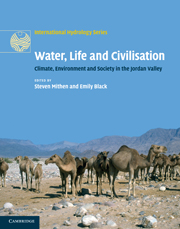Book contents
- Frontmatter
- Contents
- List of figures
- List of tables
- List of contributors
- Acknowledgements
- 1 Introduction: an interdisciplinary approach to Water, Life and Civilisation
- Part I Past, present and future climate
- Part II The palaeoenvironmental record
- Part III Hydrological studies of the Jordan Valley
- 10 The impacts of climate change on rainfall-runoff in the upper River Jordan: methodology and first projections
- 11 Modelling Dead Sea levels and rainfall: past, present and future
- 12 The hydrology of the Wadi Faynan
- 13 Future projections of water availability in a semi-arid region of the eastern Mediterranean: a case study of Wadi Hasa, Jordan
- Part IV Human settlement, climate change, hydrology and water management
- Part V Palaeoeconomies and developing archaeological methodologies
- Part VI Society, economy and water today
- Part VII Conclusions
- Index
- Plate section
- References
10 - The impacts of climate change on rainfall-runoff in the upper River Jordan: methodology and first projections
from Part III - Hydrological studies of the Jordan Valley
Published online by Cambridge University Press: 26 April 2011
- Frontmatter
- Contents
- List of figures
- List of tables
- List of contributors
- Acknowledgements
- 1 Introduction: an interdisciplinary approach to Water, Life and Civilisation
- Part I Past, present and future climate
- Part II The palaeoenvironmental record
- Part III Hydrological studies of the Jordan Valley
- 10 The impacts of climate change on rainfall-runoff in the upper River Jordan: methodology and first projections
- 11 Modelling Dead Sea levels and rainfall: past, present and future
- 12 The hydrology of the Wadi Faynan
- 13 Future projections of water availability in a semi-arid region of the eastern Mediterranean: a case study of Wadi Hasa, Jordan
- Part IV Human settlement, climate change, hydrology and water management
- Part V Palaeoeconomies and developing archaeological methodologies
- Part VI Society, economy and water today
- Part VII Conclusions
- Index
- Plate section
- References
Summary
ABSTRACT
This chapter is concerned with the development and application of a modelling framework to investigate the sensitivity of the flows in the upper River Jordan to changes in daily and seasonal rainfall patterns, and the likely changes in the daily runoff in response to anthropogenic climate change. To this end, idealised climate scenarios as well as projections of future near-surface air temperature and precipitation from the HadRM3 climate model are used with a modelling framework incorporating the Pitman and INCA rainfall-runoff models to determine flow sensitivity to rainfall and the flow response to a scenario of projected climate change. The Pitman model was used to estimate the hydrologically effective rainfall (HER); the INCA model was used for simplified flood-routing. The INCA model was calibrated for the period 1989 to 1993, commensurate with the observed daily mean flows, and the goodness of fit coefficient R2 was 0.7, indicating a good fit to the observed dynamics, although the simulated flows were an overestimate of those observed owing to unquantifiable river abstractions. On a seasonal timescale, comparison between sensitivity scenarios with long and short rainy seasons showed that rainfall in the winter months had the greatest impact on flow. In response to projected changes in the climate for 2071–2100, the modelled flood flows in the scenario period were reduced by approximately 31% for the largest simulated flood and 25% for the 10th percentile flow in comparison to those in the control period from 1961 to 1990. […]
- Type
- Chapter
- Information
- Water, Life and CivilisationClimate, Environment and Society in the Jordan Valley, pp. 131 - 146Publisher: Cambridge University PressPrint publication year: 2011



